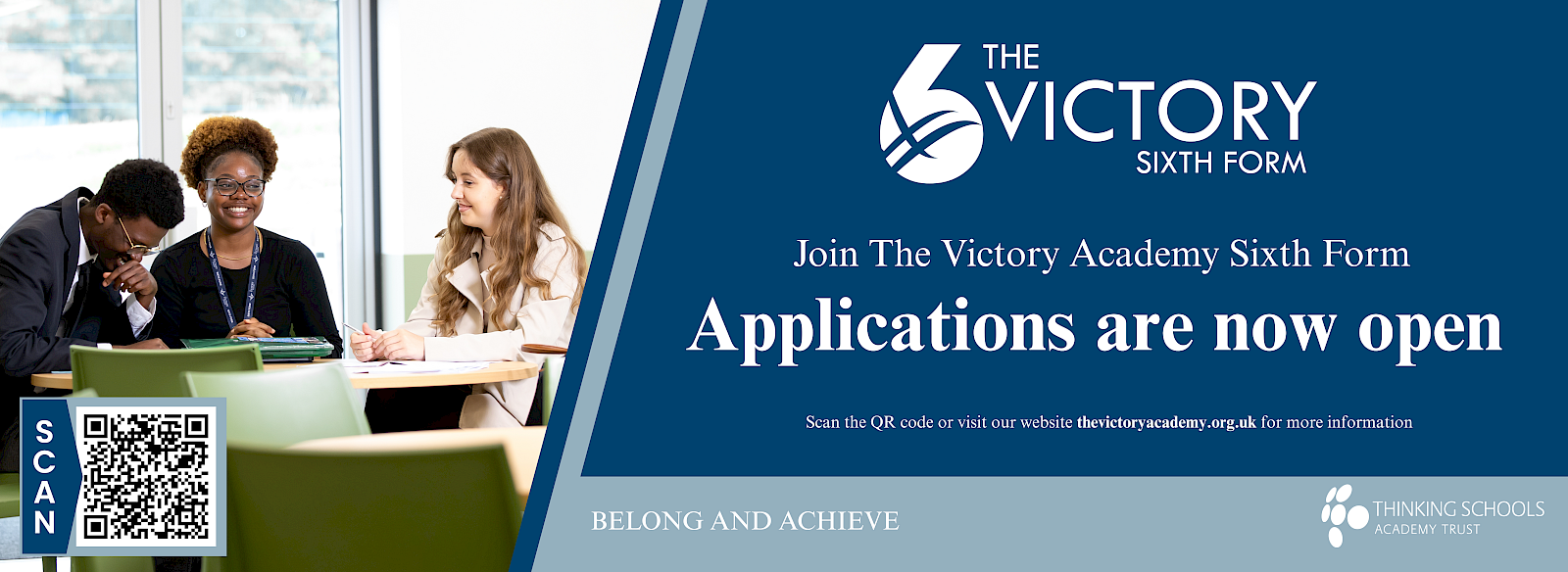
Applications for The Victory Academy Sixth Form are now open! To apply please click here.

Applications for The Victory Academy Sixth Form are now open! To apply please click here.
In the Art department at The Victory Academy, we aim for our students to become confident, independent, aspirational and creative thinkers. We aim to develop students’ awareness of their own strengths, imagination and practical skills, through a balanced programme of study. Students’ acquire effective habits, take pride in their learning and develop a culture of respect for all. Our focus is to expand student’s cultural capital, through the investigation of different materials, exploration of artists from different backgrounds and to experience the visual Arts world around them. We wish to equip our students with the tools needed to make sense of the many images they see, and master visual literacy, which is essential to their growth as members of society and becoming global citizens.
Our aim is to build long term knowledge and critical skills, whilst fostering their understanding of themselves to develop their individual ideas and voices. Art plays an important role in the development of an individual’s understanding of empathy and emotional awareness, educating our students to become emotionally intelligent people. Our aspirational goal is for our students to share the belief that Art is a uniquely powerful subject, representing creative practices that shape our shared world.
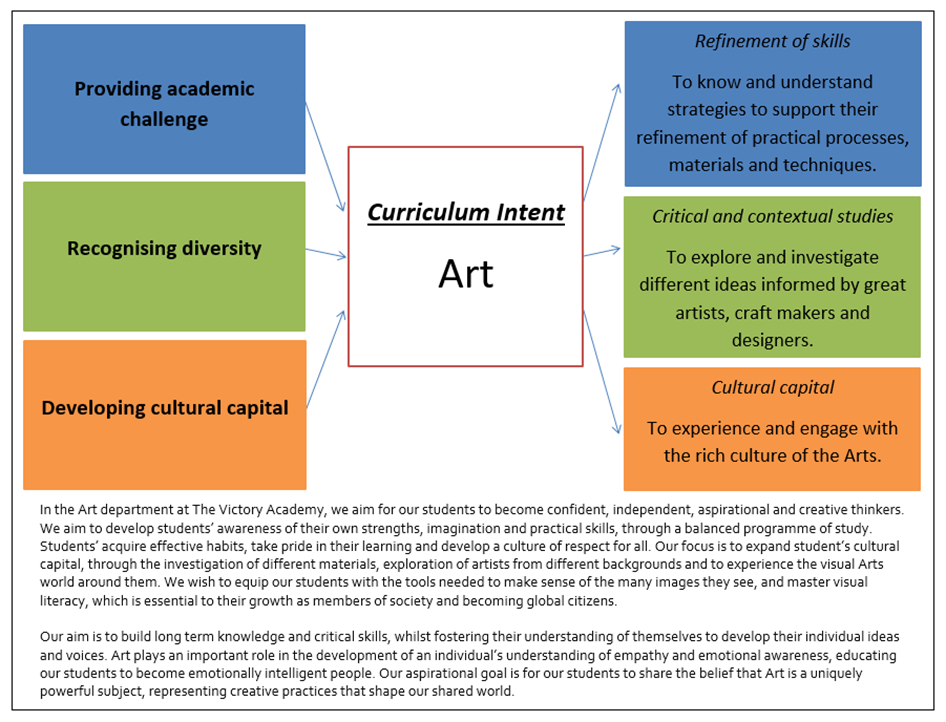

| Course Title | Qualifications Obtainable | Awarding Body |
|---|---|---|
| Key Stage 4 Courses | ||
| GCSE Art and Design: Graphic Communication | GCSE | AQA |
| GCSE Art and Design: Fine Art | GCSE | AQA |
| GCSE Art and Design: Textile Design | GCSE | AQA |
| Key Stage 5 Courses | ||
| A Level Art and Design: Fine Art | A Level | AQA |
| BTEC National Extended Certificate in Art and Design | BTEC Level 3 | Edexcel |
| BTEC Foundation Diploma Art and Design | BTEC Level 3 | Edexcel |
Art, craft and design embody some of the highest forms of human creativity. A high-quality Art education should engage, inspire and challenge pupils, equipping them with the knowledge and skills to experiment, invent and create their own works of art, craft and design. As students progress, they should be able to think critically and develop a more rigorous understanding of Art and Design. They should also know how Art and Design both reflect and shape our history, and contribute to the culture, creativity and wealth of our nation.
Each unit students will learn a new skill based around the formal elements of art. Students will be taught to record their observations and develop confidence and skills in using pencil, paint, sculpture and printmaking techniques.
Students will study a different artist, art movement or art form within each project that will develop their understanding and cultural development of their own work and to be critical thinkers. From looking at art from a range of cultures students will gain a deeper understanding of the world around them and arts diverse role in society.
Students will be taught:

Welcome to the start of our Art curriculum journey. Year 7, follow a programme of study that is designed for students to experience working with a range of materials and learn about artists from different periods of time and movements, within Art history. The year 7 curriculum focuses on building knowledge and practical skills through the disciplines of drawing, painting, mixed media and three- dimensional work. We deliver multiple miniature projects throughout year 7 to build a foundation of knowledge and skills. Students will start their journey by developing their observational drawing skills and students use and understanding of colour theory. Within each project, a different artist is discussed and their work is viewed, analysed and then responded to through a practical activity. Each activity explores a different creative technique and process, from collage to printing and painting. There is a particular focus on the Art of portraiture and an introduction to relief sculpture. Throughout year 7, an emphasis is placed on building student confidence to discuss their work, working interdependently, analysing artists work and use of specialist Art vocabulary.

Year 8 focuses upon building and expanding skills and techniques learnt in year 7, through longer sustained projects. Our year 8 curriculum focuses on three main projects. The year starts with a cultural fusion project, where students learn about the Mexican celebration of the Day of the Dead and the Buddhist tradition of Mandala. Within this project, students explore the fundamentals of composition, drawing and printmaking techniques to develop a cultural fusion design of their own. The second project focuses on visual language, learning to link emotions through colour and body language, developing drawing and design skills. This project also includes an illustration based collaborative mural and school house mascot design, that they develop to create a final piece, through the processes and techniques of ceramic sculpture. The third project of the year is formed around the theme of animals; this is an artist lead investigation, which develops to a final piece that is a personal response inspired by the artists studied. Throughout each of the three projects, students make final connections with the work of other’s, develop final ideas and outcomes, which they learn to evaluate using key specialist vocabulary.

Our Year 9 curriculum is designed to prepare students for KS4 Art and Design. Students will be working on one sustained project throughout the year, formed around the theme of ‘Food’ they will explore and experiment with a wide range of media, techniques and styles. They learn to build their practical skills through the contemporary and historic styles of other artists and designers. Students begin the year developing their drawing skills, focusing on perspective, contour drawing, value and mark marking techniques to explore texture. Students then begin to build these fundamentals into colour, taking inspiration from a variety of contemporary artists to explore the techniques of a range of colour-based media, including pencils, paints and inks. After an exploration of 2D materials, students refine their knowledge and skills with 3D materials and techniques, experimenting with relief, moulding and casting. Later in the year students continue to build, their knowledge and practical skills through the art of printmaking and traditional methods of oil pastel drawing and painting. Throughout the project students research and investigate artists of different times, styles and specialisms to learn to interpret their own responses to these creative ideas. They will make final connections with the work of others, develop final ideas and evaluate using specialist vocabulary.
Students receive regular verbal and formative feedback to enable them to develop their skills across each discipline and will also complete a summative assessment at the end of each term. Summative assessments will take the form of students creating a series of experiments and a final piece which will be reflected on throughout projects and a grade will be fed back at the end. All students will be taught to analyse and evaluate their own work and the work of others in order to strengthen their outcomes. They are expected to know, apply and understand the matters, skills and processes specified in the programme of study.
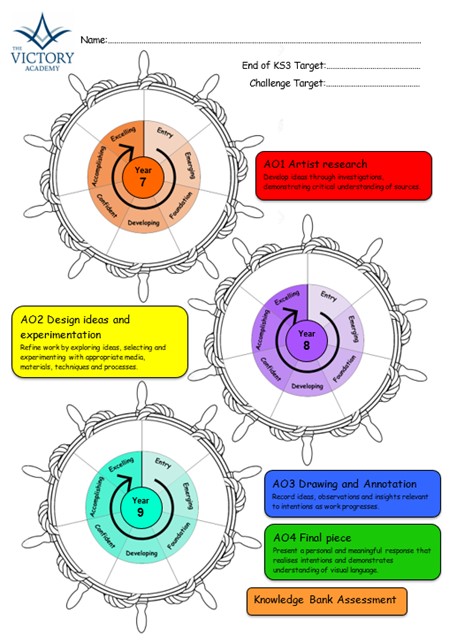
We provide a rich extracurricular activities programme and regular afterschool workshops to provide opportunities to develop creativity and an understanding of visual language. We celebrate the arts through the organisation of trips, visiting artists, exhibitions and competitions to provide students with a rich Arts experience.
Art offers three qualifications for Key Stage 4, GCSE Art and Design: Fine Art, GCSE Art and Design: Graphic Communication and GCSE Art and Design: Textile Design, all are level 2 qualifications.
All three GCSE qualifications have two components, comprising a ‘Portfolio’ selected from the course of study and an ‘Externally set assignment’, the specification provides students with a range of creative, exciting and stimulating opportunities to develop and explore their personal interests in Art and Design. It allows for progression from Key Stage 3 whilst providing a strong foundation for further study at A-level, as well as vocational pathways. To support this progression, the assessment objectives, structure and titles are very similar to those of the A-level Art and Design specification.
The difference between the three Art and Design qualifications can be defined by:
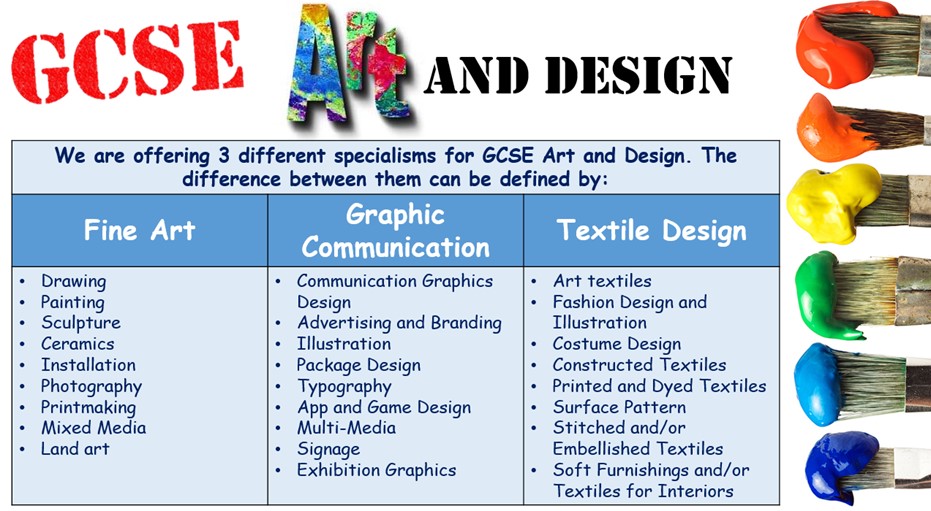
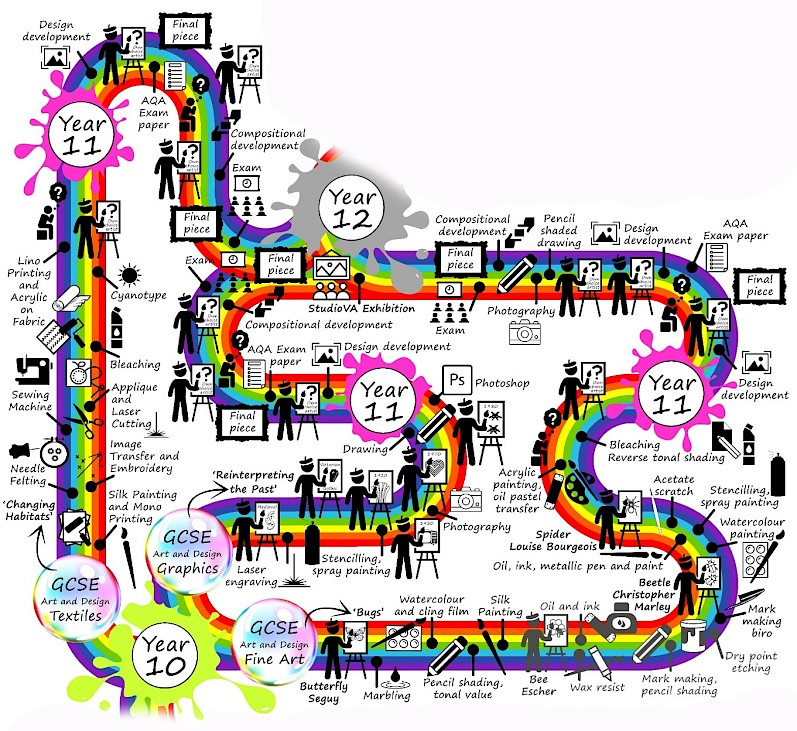
Students who opt to take Art and Design for GCSE begin their studies in year 10. GCSE Art and Design is a 2 year program, throughout which students will continue to develop their artistic skills and creativity. Students begin their ‘Portfolio’ component of the GCSE qualification from the very beginning, which is the coursework section and worth 60% of the qualification. For Fine Art our year 10 curriculum explores the starting point of ‘Bugs’, for Graphic Communication ‘Reinterpreting the Past’ and Textiles Design ‘Changing Habitats’, all are presented creatively within a sketchbook. Within these sustained projects students will experiment with a large variety of media, material and techniques, some of which they would have explored before and therefore refining their past knowledge and experience and some of which will be completely new to them. Connections will be made with the work of relevant artists to develop skills in understanding of media and concept of ideas. After four terms of more structured support, students are encouraged to work on a more independent level, developing individual outcomes by connecting to their own interests and beliefs.
For the second year of GCSE Art and Design, students work up until the end of term 2 on their ‘Portfolio’ section of the qualification. Working independently to develop individual outcomes by connecting to their own interests and beliefs. Students will create a range of personal ideas and refine these, exploring a range of relevant media and research. This project will culminate in a final outcome, in a media of their own choice (e.g. painting, print, mixed media, sculpture, photography, photoshop design, drawn illustration, laser engraving, silk painting, stitched textiles design etc.). From term 3 onwards students will be working on the ‘Externally set assignment’ sent from the exam board AQA, which is worth 40% of the qualification. Students select a starting point from the exam paper and select appropriate artists to study and investigate, which they will take inspiration from to develop their own ideas, designs and concepts. This practical and written investigation will culminate into a final outcome, which will be completed within a 10 hour exam/supervised period of time.
Students receive regular verbal and formative feedback to enable them to develop and record their ideas, experiment with a wide range of materials and techniques and present their work in a personal and meaningful way. Students receive summative assessment after each double sketchbook page to support coursework development and refinement of skill. Student portfolios are accessed internally and externally by the exam board.
Art offers three qualifications for Key Stage 5, A Level Art and Design: Fine Art, BTEC National Extended Certificate in Art and Design and BTEC Foundation Diploma Art and Design, all are level 3 qualifications.
The A Level qualification has two components, comprising of a ‘Personal investigation’ and an ‘Externally set assignment’. Students are required to conduct a practical investigation, into an idea, issue, concept or theme, supported by written material. The focus of the investigation must be identified independently by the student and must lead to a finished outcome or a series of related finished outcomes. The specification directly supports the progression to further and higher education in Art and Design and related subjects, as well as providing all students with a platform to inspire a lifelong interest in, and enjoyment of, Art and Design.
The Pearson BTEC qualifications have been designed for 6th formers who may wish to explore a vocational route throughout Key Stage 5. The BTEC Extended Certificate is equivalent in size to one A Level and includes 4 units, of which 2 are external exams. The BTEC Foundation Diploma Art and Design is equivalent in size to two A Levels and includes 6 units, of which 2 are external exams. These qualifications give students specialist knowledge and skills, enabling entry to an Apprenticeship or other employment, or progression to related higher education courses. Students will develop art and design projects and gain an understanding of the creative process. They will study visual recording and communication, critical analysis and production skills to produce art and design outcomes. The qualification is designed for Post-16 learners who aim to progress to higher education and ultimately to employment, possibly in the creative industries.
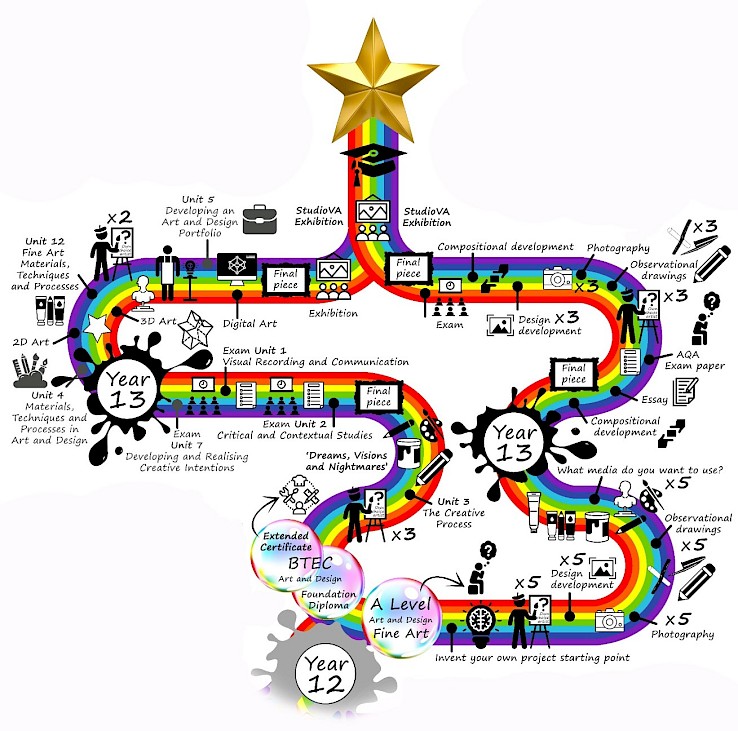
A Level Art and Design: Fine Art
Students who opt to take Fine Art for A Level begin their studies in year 12. A Level Art and Design is a 2 year program, throughout which students will continue to develop their independent artistic skills and creativity. Students begin their ‘Personal investigation’ component of the A Level qualification from the very beginning, which is the coursework section and worth 60% of the qualification. This component allows students opportunities to generate and develop ideas, research primary and contextual sources, record practical and written observations, experiment with media and processes and refine ideas towards producing resolved outcomes. Within year 12 students create their own starting point of their project and begin the research and investigation into the multiple artist they wish to study. Throughout this year, students are involved in workshops into new medias as well as developing refinement of skills learnt throughout their Art journey so far.
For the final year of A Level Art and Design, students work up until the end of term 2 on their ‘Personal investigation’ section of the qualification. Students build upon their personal investigation work started in year 12, creating a further development and outcome, exploring their own personal theme and interest. To support their practical work students also write an accompanying personal study essay exploring key artists, which have influenced their work. From February, students will be working on the ‘Externally set assignment’ sent from the exam board AQA, which is worth 40% of the qualification. Students select a starting point from the exam paper and select appropriate artists to study and investigate, which they will take inspiration from to develop their own ideas, designs and concepts. This practical and written investigation will culminate into a final outcome, which will be completed within a 15 hour exam/supervised period of time.
BTEC National Extended Certificate in Art and Design and BTEC Foundation Diploma Art and Design
Students who opt to take the BTEC begin their studies in year 12. Both the Extended Certificate and Foundation Diploma are a 2-year program of study and students will work towards completing coursework unit(s) and external exam unit(s) within their first year. The first project theme is inspired by the ‘Dreams, visions and nightmares’ and includes unit 3 ‘The creative process’ and unit 12 ‘Fine Art materials, techniques and process’, and for the Foundation Diploma students will also include unit 4 ‘Materials techniques and processes in Art and Design’ and unit 10 ‘3D techniques, materials and processes’. Students will research the title, along with a selection of artists. They experiment with textile techniques, analyse their own and others work to create a refined final piece and be able to justify decisions. The external exam students will be working towards is unit 2 ‘Critical and contextual studies in Art and Design’, within this unit students respond to research and experimentation producing a variety of ideas initially, refining down to one final design.
For the second year, students will work towards completing their coursework units and second external exam required for the qualification. Students respond to research and experimentation producing a variety of ideas initially, refining down to one final design. Students create a refined final piece informed by research and experimentation. Students will photograph and present all work in a digital portfolio with appropriate annotation. The final exam is unit 1 ‘Visual recording and communication, where students will prepare all outcomes for studio VA exhibition as part of portfolio development.
Students receive fortnightly coursework deadlines with regular verbal feedback. Students also receive summative assessment after each artist and design section/unit of coursework to aid development and refinement of skill. This enables students to be prepared to go on to creative subjects at higher education and jobs in the creative industries. Student portfolios/units are accessed internally and externally by the exam board.
The UK’s creative industries are developing new jobs faster than other sectors and we pride ourselves on keeping up to date with the latest advances and technologies. The creative industries generate more than £100 billion a year to the UK economy and employ more than 2 million people. About 1 in 8 UK businesses are in the creative industries, with an estimated 2,040,000 jobs. There is a high demand for creative thinkers in all sectors. These skills go beyond what is needed to achieve at exam level and focus on equipping our students with the ability to be to be creative, to organise, to reflect and to self-improve.
Our curriculum develops awareness of the career opportunities for students, through daily links in our lessons and the many enrichment opportunities the department offers. This includes trips, industry workshops run by professional practitioners, internal and external shows, visits to local higher education institutions, career and portfolio talks, design challenges and competitions. Students will develop cultural capital by having the opportunity to engage in activities that prepare them for the world of work and further education, informing their decisions when choosing whether to study art further and giving them the confidence to work within the creative sectors.
Just some of the University courses in the creative sector:
If not university, check out a creative apprenticeship near you:
https://www.apprenticeships.gov.uk/apprentices/browse-apprenticeships
Just some of the artistic careers in the creative sector:
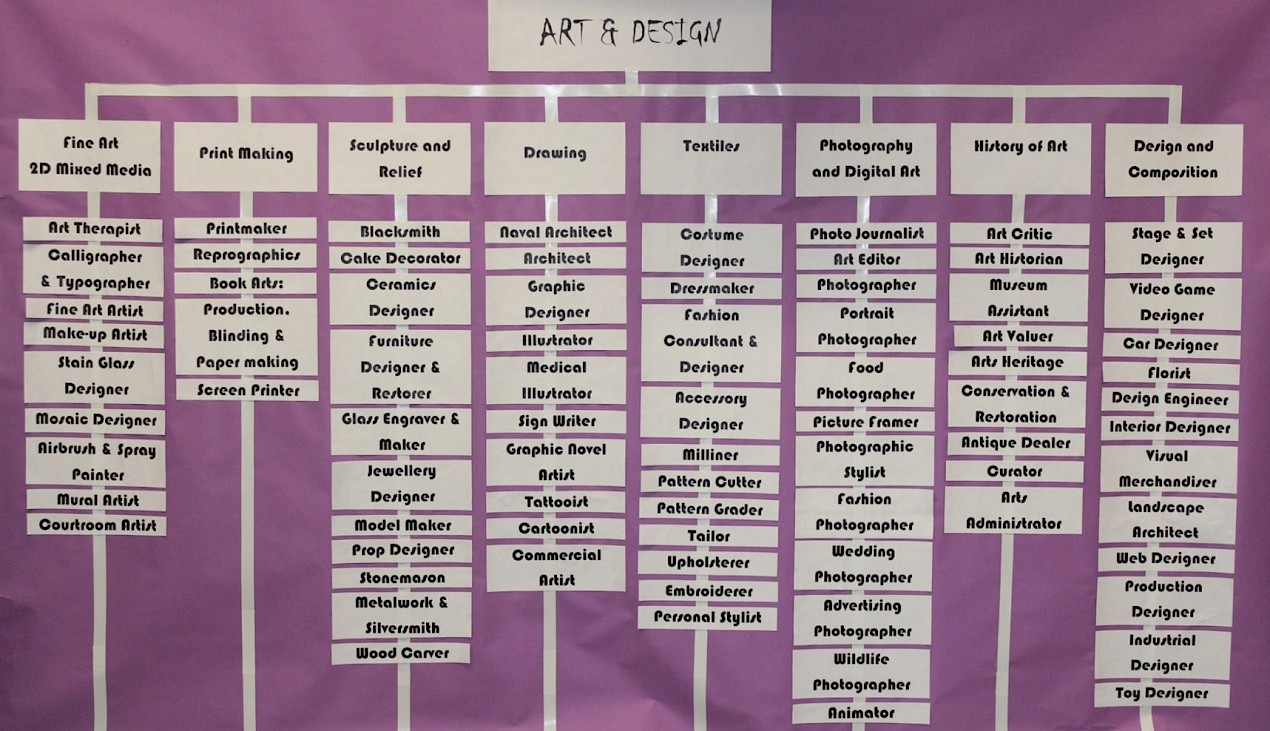
https://www.bbc.co.uk/bitesize/subjects/z6hs34j
https://www.studentartguide.com/
https://www.designcouncil.org.uk/
https://www.britishmuseum.org/
https://mastersof.photography/photostream/
https://www.roh.org.uk/learning/royal-opera-house-bridge
https://www.artscouncil.org.uk/
Photography Tips from the Top Floor – Chris Marquardt
Talk Art – Russell Tovey and Robert Diament
The Week in Art – The Art Newspaper
Meet Me at the Museum – Art Fund
Art Monthly - https://www.artmonthly.co.uk/
Art Review - https://artreview.com/
Artists and illustrators - https://www.artistsandillustrators.co.uk/contact-us
British Journal of Photography - https://www.bjp-online.com/
Crafts Magazine - https://www.craftscouncil.org.uk/crafts-magazine/explore-recent-issues-crafts-magazine
Creative Review - https://www.creativereview.co.uk/
Contemporary- https://www.contemporaryand.com/magazine/